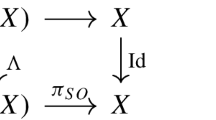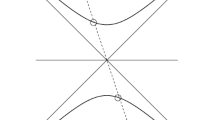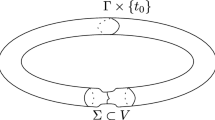Abstract
In this paper, we present a combinatorial characterization of a quasi-Hermitian surface as a set \({\mathcal {H}}\) of points of \(\textrm{PG}(3,q)\), \(q=p^{2h}\) \(h\ge 1\), p a prime number and \(q\ne 4\), having the same size as the Hermitian surface and containing no plane, such that either a line is contained in \({\mathcal {H}}\) or intersects \({\mathcal {H}}\) in at most \(\sqrt{q}+1\) points and every plane intersects \({\mathcal {H}}\) in at least \(q\sqrt{q}+1\) points. Moreover, if there is no external line, the set \({\mathcal {H}}\) is a Hermitian surface.
Similar content being viewed by others
Avoid common mistakes on your manuscript.
1 Introduction
Hermitian varieties over finite fields have particular properties which make them nice and interesting geometric objects connected to other combinatorial structures such as e.g. (linear) codes, strongly regular graphs, (two-class) association schemes and block designs (cf e.g. [2, 3, 11]). Thus, there is a wide literature devoted to Hermitian varieties, in particular results of characterization (cf e.g. [4, 7,8,9] and the references cited therein).
These results either use only purely geometric-combinatorial considerations (an approach which is called the Beniamino Segre point of view in (finite) geometry [1]) or they use algebraic geometry over finite fields. An example of the latter approach is the paper [5] in which the authors give a characterization of Hermitian surfaces of \(\textrm{PG}(3, q)\), \(q= p^{2\,h}\), p prime, as surfaces of degree \(\sqrt{q}+1\) without \({\mathbb {F}}_q\)-plane components and of maximal size (i.e. meeting the Homma–Kim elementary upper bound for surfaces of degree d with no \({\mathbb {F}}_q\)-plane components in \(\textrm{PG}(3, q)\), cf [6]). In the proof of this result the plane sections of the surface play a special role, and since most of recent geometric-combinatorial characterizations of Hermitian surfaces are based on the sizes (or the possible number of sizes) of the plane sections, this result suggest in a geometric-combinatorial approach to study Hermitian surfaces via their plane sections without assuming that the possible sizes of the sections are exactly two or are precisely those of a Hermitian surface.
In this paper, we give a new combinatorial characterization of the Hermitian surface in \(\textrm{PG}(3, q)\) following this idea.
Before to state our result, let’s quickly recall the definitions of Hermitian variety and quasi-Hermitian surface. A (nonsingular) Hermitian variety of \(\textrm{PG}(n, q)\), q a square of a prime power, over \({{\mathbb {F}}}_q\) is a variety projectively equivalent to the variety
over \({{\mathbb {F}}}_q\). Its number of \({{\mathbb {F}}}_q\)-points is \((\sqrt{q}^{n+1}+(-1)^n)(\sqrt{q}^{n}+(-1)^{(n-1)})/(q-1)\). For \(n=3\), we have that a (nonsingular) Hermitian surface is a set of \((q\sqrt{q} + 1)(q+1)\) points of \(\textrm{PG}(3, q)\), \(q=p^{2\,h}, h\ge 1\), p prime, intersected by any line in 1, \(\sqrt{q}+1\) or \(q+1\) points and by every plane either in \(q\sqrt{q}+1\) or \(q\sqrt{q}+q+1\) points.
A subset of points of \(\textrm{PG}(3, q)\) is a quasi-Hermitian surface if the sizes of its intersections with the planes of \(\textrm{PG}(3, q)\) are exactly two and they are precisely those of a Hermitian surface of \(\textrm{PG}(3, q)\), that is \(q\sqrt{q}+1\) and \(q\sqrt{q}+q+1\) (cf [4, 9]).
Let \({\mathcal {H}}\) be a subset of points of \(\textrm{PG}(r, q)\), an external line is a line \(\ell \) such that \(\ell \cap {\mathcal H}= \emptyset \).
Our result reads as follows.
Theorem I Let \({\mathcal {H}}\) be a subset of \((q\sqrt{q}+1)(q+1)\) points of \(\textrm{PG}(3, q)\), with \(q= p^{2\,h}\), \(h\ge 1\), p a prime number and \(q\ne 4\), such that
-
(i)
if \(\ell \) is a line with \(\vert {{\mathcal {H}}}\cap \ell \vert \ge \sqrt{q}+2\) then \(\ell \) is contained in \({\mathcal {H}}\),
-
(ii)
\({\mathcal {H}}\) contains no plane and \(\vert \pi \cap {{\mathcal {H}}}\vert \ge q\sqrt{q}+1\) for every plane \(\pi \) such that \(\pi \cap {{\mathcal {H}}}\ne \emptyset \).
Then \({\mathcal {H}}\) is a quasi-Hermitian surface of \(\textrm{PG}(3, q)\). If there is no external line, then \({\mathcal {H}}\) is a Hermitian surface.
Note that the set of points on \(q\sqrt{q}+1\) pairwise skew lines has size \((q\sqrt{q}+1)(q+1)\) and it is intersected by any plane either in \(q\sqrt{q}+1\) points or \(q\sqrt{q}+q+1\) points and has external lines, that is it is a quasi-Hermitian surface with external lines. Moreover Property (i), which is fulfilled by a surface of order \(\sqrt{q}+1\), together with the assumption that \({\mathcal {H}}\) contains no plane and has the same number of points as a Hermitian surface will allow us to prove, with only combinatorial considerations, that the plane sections of \({\mathcal {H}}\) have size at most \(q\sqrt{q}+q+1\), a step which is similar to the one of the proof of the above mentioned Homma and Kim characterization of Hermitian surfaces, in which they use a result of B. Segre [ [10], Teorema I page 29 and Osservazione IV page 33] on the number of \({{\mathbb {F}}}_q\)-rational points of (possibly reducible) plane curves of a given order. Furthermore, as in the Homma–Kim result, the case \(q=4\) occurs like a special one and whereas they solved it with an extra argument, we leave it as an open case.
2 Some preliminary definitions and results
Let k be a positive integer and let \({\mathcal {K}}\) be a non-empty set of k points of \(\textrm{PG}(3, q)\) different from \(\textrm{PG}(3, q)\), \({{\mathcal {S}}}_2\) be the family of all the planes of \(\textrm{PG}(3, q)\) and let \(c_i\), \(i=0, \ldots , q^2+q+1\) denote the number of planes intersecting \({\mathcal {K}}\) in exactly i points. Even if one may find the following countings in some papers devoted to the study k-sets of \(\textrm{PG}(r,q)\) via their intersections with the family of all the d-dimensional subspaces \(d\ge 2\), to make the paper self-contained we prefer recall them briefly.
Let
Double counting arguments give
Rewrite Eq. (2.3) in the following form
and put
From equations (2.1), (2.2), (2.3) and (2.4) it follows that
Thus,
and
It follows that
Proposition 2.1
If \({\mathcal {K}}\) has no external plane then \(g(k, m, n) \le 0\) and equality occurs if and only if any plane of \(\textrm{PG}(3, q)\) intersects \({\mathcal {K}}\) is m or n points, and both the intersection sizes with planes m and n occur.
When one needs to be more precise on the size of the intersections of a set of points of a projective space with the planes and/or lines or the number of these sizes is small, one may use the following notions.
Let \({{\mathbb {P}}}=\textrm{PG}(n, q)\) be the n-dimensional (desarguesian) projective space of order q, and \(m_1, \ldots , m_s\) be s integers such that \(0\le m_1< \cdots < m_s\) and for any integer h, \(1\le h\le n-1\), let \({{\mathcal {P}}}_h\) denote the family of all the h-dimensional subspaces of \({\mathbb {P}}\). A subset \({\mathcal {K}}\) of k points of \({\mathbb {P}}\) is a k-set of class \([m_1, \ldots , m_s]_h\) if \(\vert {{\mathcal {K}}}\cap \pi \vert \in \{m_1, \ldots , m_s\}\) for every \(\pi \in {{\mathcal {P}}}_h\). Furthermore, if for every \(m_j\in \{m_1, \ldots , m_s\}\) there is at least one subspace \(\pi \in {{\mathcal {P}}}_h\) such that \(\vert {\mathcal K}\cap \pi \vert = m_j\) \({\mathcal {K}}\) is of type \((m_1, \ldots , m_s)_h\). The integers \(m_1, \ldots , m_s\) are the intersection numbers of \({\mathcal {K}}\) (with respect to the dimension h). If \(h=1, 2\) one says that \({\mathcal {K}}\) is of line (plane)-class (type) \([m_1, \ldots , m_s]_h\) (resp. \((m_1, \ldots , m_s)_h\)).
Hence an Hermitian surface of \(\textrm{PG}(3, q)\), with q a square, is a \((q\sqrt{q}+1)(q+1)\)-set of line-type \((1, \sqrt{q} +1, q+1)_1\) and plane-type \((q\sqrt{q}+1, q\sqrt{q}+q+1)_2\), and a quasi-Hermitian surface is a set of points of \(\mathrm {PG(3, q)}\), q square, of plane-type \((q\sqrt{q}+1, q\sqrt{q}+q+1)_2\)
Let \({\mathcal {K}}\) be a subset of points of \({\mathbb {P}}\), a line (plane) intersecting \({\mathcal {K}}\) in exactly i points is called i-line (plane). If \(i=1\) a 1-line (plane) is called tangent.
We end this section by recalling a characterization result of Hermitian surfaces in terms of their line-class and plane-type.
Theorem 2.2
([7]). In \(\textrm{PG}(3, q^2)\) a \((q^5+q^3+q^2+1)\)-set of line-class \([1, 2, \ldots , q+1, q^2+1]_1\) and plane-type \((m, n)_2\) is a Hermitian surface.
3 The proof
Let \(q = p^{2h}\), with p a prime number and \(h \ge 1\). Let \({\mathcal {H}}\) be a subset of points of \(\textrm{PG}(3, q)\) satisfying the assumptions of Theorem I.
Note that by the assumption that \({\mathcal {H}}\) contains no plane it follows that if \(\pi \) is a plane, then through any point of \(\pi \) there pass at most \(\sqrt{q}+1\) \((q+1)\)-lines.
If \(\pi \) is a plane, let \(v_\pi = \vert {{\mathcal {H}}}\cap \pi \vert \).
Lemma 3.1
If \(q\ne 4\) then \(v_\pi \le q\sqrt{q}+q+1\) for every plane \(\pi \).
Proof
Let \(\pi \) be a plane of \(\textrm{PG}(3, q)\). If \(\pi \) contains no \((q+1)\)-line let p be a point in \(\pi \cap {\mathcal {H}}\). Counting the number of points of \(\pi \) through the lines on p gives \(v_\pi \le 1+(q+1)\sqrt{q} < q\sqrt{q}+q+1\). So we may assume that \(\pi \) contains a \((q+1)\)-line, say \(\ell \). If \(\ell \) contains a point p such that \(\ell \) is the only \((q+1)\)-line through \(\ell \), then \(v_\pi \le q+1+q\sqrt{q}\) as required. Thus, we may assume that in \(\pi \) all the points of \(\ell \) are on at least two \((q+1)\)-lines. Then in \(\pi \) there is no line with at most \(\sqrt{q}-1\) points. Otherwise, since any two lines of \(\pi \) meet each other, counting the number of \((q+1)\)-lines of \(\pi \) meeting a line with at most \(\sqrt{q}-1\) points gives that this number is at most \((\sqrt{q}-1)(\sqrt{q}+1)= q-1\). On the other hand, since any point of \(\ell \) is on at least two \((q+1)\)-lines of \(\pi \), one has that there are at least \(q+2\) \((q+1)\)-lines, a contradiction. So, any line of \(\pi \) has at least \(\sqrt{q}\) points in common with \({\mathcal {H}}\). If \(\ell \) contains a point on at least three \((q+1)\)-lines, then \(v_\pi \ge q+1+q+q+(q-2)(\sqrt{q}-1)= q\sqrt{q}+2q-2\sqrt{q}+3\). On the other hand, counting the number of points of \(\pi \cap {\mathcal {H}}\) through the lines on a point of \(\pi \) not in \({\mathcal {H}}\) gives \(v_\pi \le (q+1)(\sqrt{q}+1) = q\sqrt{q}+q+\sqrt{q}+1\). Thus,
that is
which is not possible, since \(q\ne 4\).Footnote 1
So every point of \(\ell \) is on exactly two \((q+1)\)-lines. Hence the number of \((q+1)\)-lines of \(\pi \) is \(q+2\). Every point of each of these \((q+1)\)-lines is on at least two \((q+1)\)-lines, otherwise we are done, by the previous argument. Since there are exactly \(q+2\) \((q+1)\)-line it follows that on each point of one of these \((q+1)\)-lines there pass exactly two \((q+1)\)-lines.
If there is a point of \(\pi \cap {\mathcal {H}}\) on no \((q+1)\)-line, then the assertion is true. So on each point of \(\pi \cap {\mathcal {H}}\) there is at least one \((q+1)\)-line and so exactly two \((q+1)\)-lines. Counting in double way the incident point-line pairs (p, m) where m is a \((q+1)\)-line gives
Let p be a point of \(\pi \setminus {\mathcal {H}}\), and let y be the number of \(\sqrt{q}\)-lines through p. Then,
and so \(q\le 2\sqrt{q}\). Hence \(q=4\) (and \(y=0\)) against the assumption. \(\square \)
Remark 3.2
Actually, in the proof of the above Lemma we have used neither the fact that the plane is embedded in \(\textrm{PG}(3, q)\) nor that the plane is desarguesian. Indeed, we have proved the following result: Let \(\pi _n\) be a projective plane of square order n and let X be a subset of points of \(\pi _n\) such that
\(\bullet \) there is at least a point of \(\pi _n\) outside X,
\(\bullet \) every line \(\ell \) of \(\pi _n\) with \(\vert \ell \cap X\vert \ge \sqrt{n}+2\) is contained in X,
then \(\vert X\vert \le n\sqrt{n}+n+1\) \(n=4\) (and so \(\pi _n\) is desarguesian) \(\vert X\vert = 15\) and X is the complement of a set of line-type \((0,2)_1\) in \(\textrm{PG}(2, 4)\), that is of a 6-arc.
Proposition 3.3
Any point of \({\mathcal {H}}\) belongs to at least one \((q+1)\)-line.
Proof
If there is a point \(p\in {\mathcal {H}}\) such that every line on it shares at most \(\sqrt{q}+1\) points with \({\mathcal {H}}\) then
which is not possible. \(\square \)
It follows that there is no external plane.
Proposition 3.4
If \(\ell \) is a \((q+1)\)-line, then every plane through \(\ell \) intersects \({\mathcal {H}}\) into exactly \(q\sqrt{q}+q+1\) points.
Proof
Let \(\ell \) be a \((q+1)\)-line, then counting the number of points via the planes through \(\ell \) gives
and so every plane on \(\ell \) intersects \({\mathcal {H}}\) into exactly \(q\sqrt{q}+ q+1\) points. \(\square \)
Thus, \(q\sqrt{q}+q+1\) is the maximal size for the intersections of \({\mathcal {H}}\) with the planes.
Now, we are ready to complete the proof of Theorem I.
Let m the minimal size of the intersections of \({\mathcal {H}}\) with the planes of \(\textrm{PG}(3,q)\). Since there is no external plane then
and
Thus,
and so
that is \(m=q\sqrt{q}+1\) and \(g((q\sqrt{q}+1)((q+1), q\sqrt{q}+1, q\sqrt{q}+q+1)=0\). Thus, by Proposition 2.1 it follows that \({\mathcal {H}}\) is a quasi-Hermitian surface of \(\textrm{PG}(3, q)\). And if there is no external line, by Theorem 2.2 it follows that Theorem I is completely proved.
Data availability statement
No datasets were generated or analyzed during the current study.
Notes
Here \(q=4\) cannot occur because if \(q=4\), then the above inequalities are equalities and so \(v_\pi = 15\), on \(\ell \) there is a point, say p, on exactly three 5-lines, and the lines through a point of \(\pi \) not in \({\mathcal {H}}\) are all 3-lines. But this is not possible, since on p there are five lines and so they cover more than 15 points of \({\mathcal {H}}\) in \(\pi \).
References
Beutelspacher, A.: Geometry from Segre’s point of view: variations on a classical theme. In: Proceedings of Combinatorics ’88, Research and Lecture Notes in Mathematics, Vol. 1, Mediterranean Press, pp. 15–24 (1991)
Bose, R.C., Chakravarti, I.M.: Hermitian varieties in a finite projective space PG \((N, q^2)\). Canad. J. Math 18, 1161–1182 (1966)
Chakravarti, I.M.: Some properties and applications of Hermitian varieties in a finite projective space PG\((N, q^2)\)in the construction of strongly regular graphs (two-class association schemes) and block designs. J. Combin. Theory 11, 268–283 (1971)
De Winter, S., Schillewaert, J.: A note on quasi-Hermitian varieties and singular quasi-quadrics. Bull. Belg. Math. Soc. Simon Stevin 17, 911–918 (2010)
Homma, M., Kim, S.J.: The characterization of Hermitian surfaces by the number of points. J. Geom. 107, 509–521 (2016)
Homma, M., Kim, S.J.: An elementary bound for the number of points of a hypersurface over a finite field. Finite Fields Appl. 20, 76–83 (2013)
Innamorati, S., Zannetti, M., Zuanni, F.: Note. A combinatorial characterization of the Hermitian surface. Discrete Math. 313, 1496–1499 (2013)
Napolitano, V.: A characterization of the Hermitian variety in finite\(3\)-dimensional projective spaces. Electr. J. Combin. 22(1), 1–22 (2015)
Napolitano, V.: On quasi-Hermitian varieties in PG\((3, q^2)\). Discrete Math. 339, 511–514 (2016). https://doi.org/10.1016/j.disc.2015.09.013
Segre, B.: Le geometrie di Galois. Ann. Mat. Pura App. 48(4), 1–96 (1959)
Segre, B.: Lectures on Modern Geometry. Rome (1960)
Funding
Open access funding provided by Università degli Studi della Campania Luigi Vanvitelli within the CRUI-CARE Agreement.
Author information
Authors and Affiliations
Contributions
The author wrote and reviewed the paper.
Corresponding author
Ethics declarations
Conflict of interest
I declare that that there is no conflict of interest.
Additional information
Publisher's Note
Springer Nature remains neutral with regard to jurisdictional claims in published maps and institutional affiliations.
This research was partially supported by the Italian National Group for Algebraic and Geometric Structures and their Applications (GNSAGA - INdAM).
Rights and permissions
Open Access This article is licensed under a Creative Commons Attribution 4.0 International License, which permits use, sharing, adaptation, distribution and reproduction in any medium or format, as long as you give appropriate credit to the original author(s) and the source, provide a link to the Creative Commons licence, and indicate if changes were made. The images or other third party material in this article are included in the article's Creative Commons licence, unless indicated otherwise in a credit line to the material. If material is not included in the article's Creative Commons licence and your intended use is not permitted by statutory regulation or exceeds the permitted use, you will need to obtain permission directly from the copyright holder. To view a copy of this licence, visit http://creativecommons.org/licenses/by/4.0/.
About this article
Cite this article
Napolitano, V. A new combinatorial characterization of (quasi)-Hermitian surfaces. J. Geom. 114, 19 (2023). https://doi.org/10.1007/s00022-023-00681-7
Received:
Revised:
Accepted:
Published:
DOI: https://doi.org/10.1007/s00022-023-00681-7




